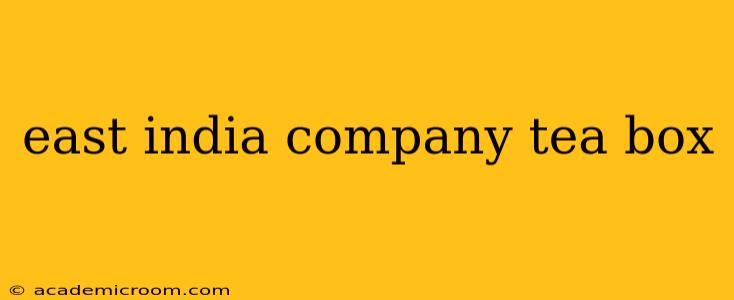The allure of a vintage East India Company tea box extends far beyond its function as mere packaging. These boxes represent a tangible link to a pivotal period in history, a time when the East India Company held a near-monopoly on the tea trade, shaping global economies and influencing cultural tastes. Collectors and tea enthusiasts alike are drawn to these beautiful artifacts, eager to uncover their stories and understand their value. This article delves into the history of these iconic boxes, exploring their design, materials, and the factors that determine their collectability and worth.
What Made East India Company Tea Boxes So Special?
The East India Company's dominance in the tea trade meant their branding was synonymous with quality and prestige. The boxes themselves reflected this status. Often crafted from high-quality materials like wood (including exotic varieties), tin, or even lacquered papier-mâché, they were meticulously designed to protect the precious cargo within. Intricate designs, embossed lettering, and vibrant colors were common, showcasing the company's wealth and influence. The boxes weren't simply containers; they were miniature works of art, designed to enhance the overall experience of consuming this luxurious commodity.
What Different Types of East India Company Tea Boxes Exist?
The types of boxes varied significantly across time and depending on the intended market. Some key variations include:
- Wooden Boxes: These were often larger, more substantial containers, sometimes featuring intricate carvings or inlaid designs, suitable for storing larger quantities of tea.
- Tin Boxes: These offered a more durable and lightweight alternative, often decorated with lithographic prints showcasing scenes of Indian life or the Company's emblems.
- Caddies: Smaller, more personal-sized containers, often made of wood or tin, intended for individual use or as gifts.
- Paperboard Boxes: While less common for high-value teas, these were used for more affordable blends.
The designs also evolved throughout the Company's history, reflecting changing artistic styles and tastes.
How Can I Identify a Genuine East India Company Tea Box?
Authenticating vintage tea boxes requires careful examination. Look for:
- Company Markings: Genuine boxes will usually feature clear markings indicating the East India Company's association, possibly including crests, logos, or lettering.
- Construction Quality: Authentic boxes are usually made with superior materials and craftsmanship compared to later reproductions. Examine the joints, hinges, and overall construction for signs of high quality.
- Age and Condition: The age and condition of the box significantly impact its value. Boxes in excellent condition, particularly those with rare or unique designs, will command higher prices.
- Provenance: Documentation tracing the box's history, if available, greatly adds to its authenticity and value.
It’s always advisable to seek expert opinion from reputable antique dealers or collectors if you're unsure about authenticity.
How Much Are East India Company Tea Boxes Worth?
The value of an East India Company tea box is highly variable and depends on several factors:
- Rarity: Unusual designs, materials, or sizes command higher prices.
- Condition: Excellent condition significantly increases value. Damage, wear, and tear reduce value.
- Size and Type: Larger, ornate boxes are generally more valuable than smaller, simpler ones.
- Market Demand: Current market trends influence prices.
While some boxes might sell for a few hundred dollars, rare and exceptional examples can fetch thousands.
Where Can I Find East India Company Tea Boxes?
Antique shops, online auction sites (like eBay), and specialized antique dealers are good places to start your search. Estate sales and flea markets can also occasionally yield exciting finds. Remember to always exercise caution and due diligence when purchasing vintage items.
What Should I Look for When Buying an East India Company Tea Box?
Beyond authentication, consider:
- Condition: Carefully inspect the box for any damage, repairs, or signs of significant wear and tear.
- Completeness: Ensure all parts are present and intact (e.g., lids, hinges).
- Authenticity: Verify the authenticity as discussed above.
- Price: Research comparable boxes to ensure you are paying a fair price.
By understanding the history, design features, and factors that determine value, you can appreciate the unique significance of these beautiful artifacts and navigate the world of East India Company tea box collecting with confidence. Remember, patience and careful research are key to discovering a truly special piece.
